
TRI-STATE
Multi-physical simulation model to evaluate thermal safety
In May 2023, the final meeting of our FFG project TRI-STATE took place in Graz. The project involved 33 months of work on the development of a combined multi-physical simulation model to evaluate thermal safety in vehicles with the partners Magna, Kreisel and the Austrian Institute of Technology. VIRTUAL VEHICLE took over the project coordination.
In addition to the issue of time and cost pressure in the development of battery electric vehicles, the topic of battery safety is becoming increasingly important. As the EVS-GTR and the legal requirements for high-voltage battery systems are still being coordinated, the control of thermal runaway is becoming more important in the development of battery systems.
These increasing safety requirements are to be taken into account in the development process in a cost- and time-saving way. This represents a major challenge for the industry. New methods must therefore be sought that enable a holistic, multidisciplinary assessment of thermal safety, which has been lacking in the virtual development process until now.
To fill this gap, a completely new combined multiphysical simulation model was developed in TRI-STATE that is capable of evaluating multidisciplinary safety scenarios.
The combined multi-physical simulation model combines the three sub-areas, Crash, Thermal Management and Thermal Runaway.
Crash
If a crash occurs and the vehicle is damaged, the battery cell may also be deformed. In order to counteract overheating or even a fire, the hotspot must be located.
In order to be able to predict short circuits better and faster, Patrick Kolm (VIRTUAL VEHICLE) is dealing with the simulation-based short-circuit prediction of Li-ion cells due to mechanical crash loads in his dissertation, for which he received the Hans List Fund. He is working on the further development of cell simulation models for improved prediction of mechanically induced short circuits.
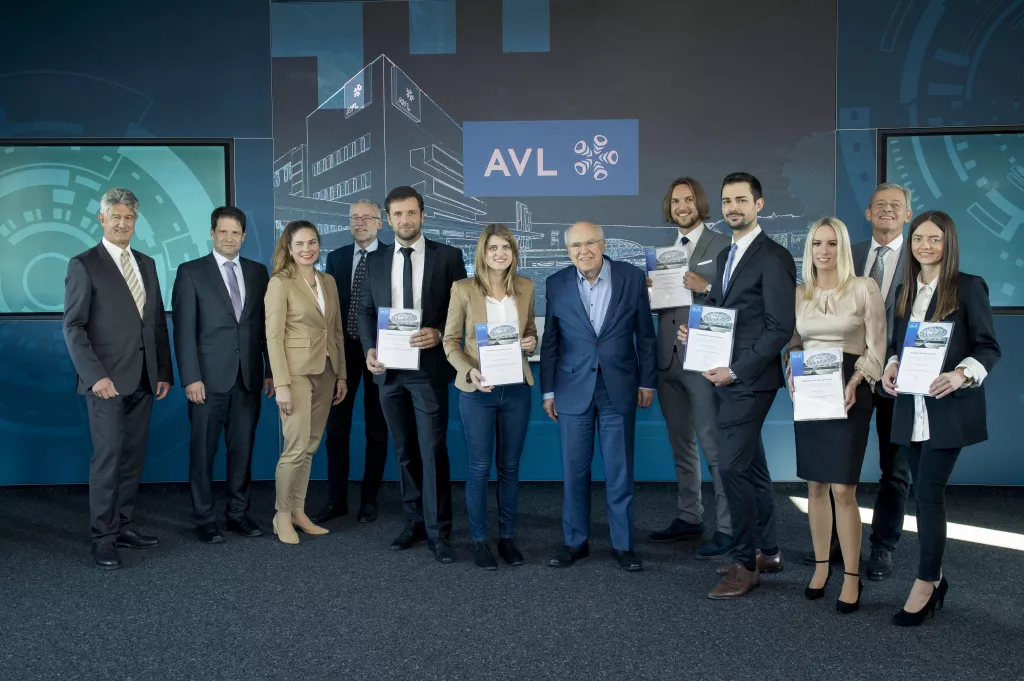
Li-ion cells are the leading battery technology in the field of electromobility due to their high efficiency during charging and discharging as well as their low self-discharge. In order to be able to evaluate the crash safety of the battery and present short-circuit predictions, a realistic mechanical finite element (FE) simulation must be used. In FE simulation, deformations and tension in the cell are simulated and calculated under the influence of force. In the process, a complex structure is broken down into many small sub-areas.
The dissertation project aims to develop improved submodels to predict short circuits in batteries more accurately. Material and cell tests are conducted to generate input parameters for the improved simulation model.
The figure below shows a 3-point bending simulation of a pouch cell, where the bending stiffness of the cell is investigated.
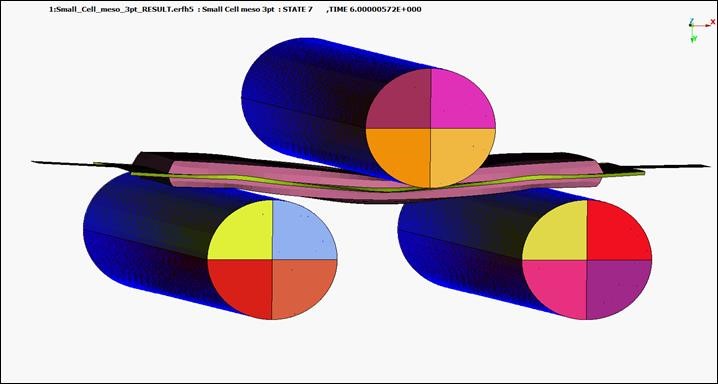
Two models are used in the crash simulation:
The figure shows a macromechanical simulation model of a pouch cell, with the detailed image showing the mesomechanical simulation approach. Here, each cell layer is modelled separately, but is homogeneous in itself. This allows a short-circuit prediction of the individual component layers. The macromechanical model is not divided into individual components, but is combined and viewed as an overall property.
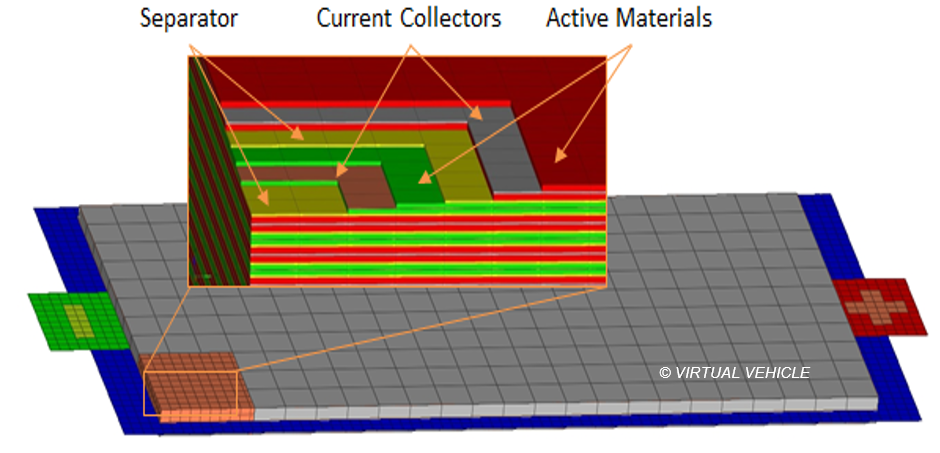
Crash simulations are carried out in advance and the results of the crash simulations are transferred to the directly coupled thermal management and thermal runaway simulation model.
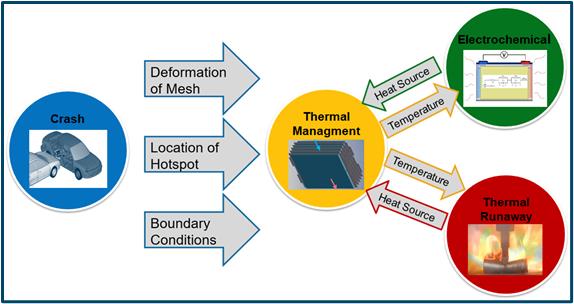
Thermal Management and Thermal Runaway
Thermal management is required to prevent or control excessive heat generation. If the battery can no longer be cooled effectively, this can lead to overheating. This in turn leads to a shortening of the service life or even total failure.
To cool the battery, there are different types of cooling depending on the battery cell:
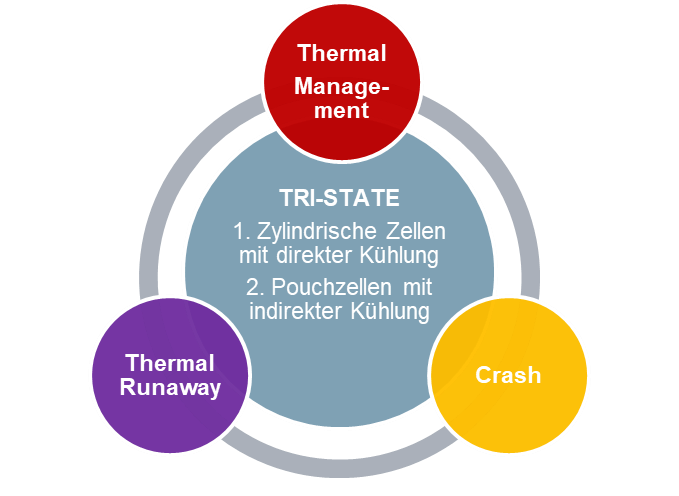
If the battery cells are no longer cooled due to the damage that has occurred and overheating is not detected in time, this can lead to an uncontrollable rise in temperature and ultimately to a fire or explosion.
The combined multi-physical simulation model was used to simulate different thermal safety scenarios with and without crash impact for two use cases, which was not possible before. The two use cases were a battery module with cylindrical cells with direct cooling and a battery module with pouch cells with indirect cooling. The simulation results were used to create new thermal safety concepts and provided new insights into multidisciplinary battery failure scenarios.
The results from TRI-STATE flow directly into follow-up activities for the ongoing FFG projects PREVENT+ and MORE+.
The results achieved will make it possible to significantly reduce the costs of test scenarios in the event of a fault by means of a holistic safety concept that can be evaluated earlier. For new system developments, a time saving of up to six weeks is achieved, which, in conjunction with the cost reduction, brings an enormous competitive advantage for Austrian industry.
